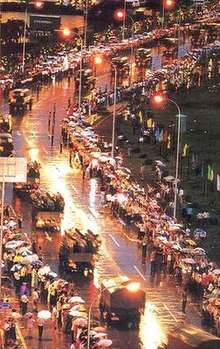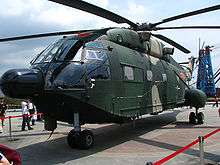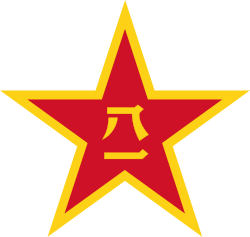People's Liberation Army Hong Kong Garrison
Coordinates: 22°16′54″N 114°09′51″E / 22.2817325°N 114.1641229°E
| People's Liberation Army Hong Kong Garrison | |
|---|---|
| 中國人民解放軍駐香港部隊 | |
.png) PLA Hong Kong Garrison arm badge | |
| Founded | 1 July 1997 |
| Service branches |
|
| Headquarters | Chinese People's Liberation Army Forces Hong Kong Building |
| Leadership | |
| Political Commissar[1] | Maj Gen Cai Yongzhong[2] |
| Commander | Lt Gen Tan Benhong |
| Manpower | |
| Active personnel | 6,000 |
| People's Liberation Army Hong Kong Garrison | |||||||||||
| Traditional Chinese | 中國人民解放軍駐香港部隊 | ||||||||||
|---|---|---|---|---|---|---|---|---|---|---|---|
| Simplified Chinese | 中国人民解放军驻香港部队 | ||||||||||
| |||||||||||
The People's Liberation Army Hong Kong Garrison is a garrison of the Chinese People's Liberation Army (PLA), responsible for defense duties in the Hong Kong Special Administrative Region since the sovereignty of Hong Kong was transferred to the PRC in 1997. Prior to the handover, Hong Kong was under British rule, and the defense of Hong Kong was the responsibility of the British Forces Overseas Hong Kong, with auxiliary help from the Royal Hong Kong Regiment.
As a non-sovereign territory, Hong Kong has never had a military force of its own. The garrison is headquartered in Chinese People's Liberation Army Forces Hong Kong Building in Central, Hong Kong. The troop strength of the Hong Kong garrison is about 6,000 personnel.
Role in Hong Kong

The Central People's Government (CPG) of the People's Republic of China (PRC) assumed sovereignty over Hong Kong on 1 July 1997 and stationed a garrison of the People's Liberation Army (PLA) in Hong Kong to manage its defense affairs. While the garrison has been considered primarily symbolic of Beijing's governance of Hong Kong, it is nevertheless a combat-ready force.[3]
The Basic Law provides that the CPG shall be responsible for the defense of Hong Kong and shall bear the expenditure for the garrison, whereas the colonial Hong Kong Government before 1997 had to pay for the military. The Garrison Law, subsequently enacted by the National People's Congress, contains specific provisions on the duties and rules of discipline of the garrison personnel, jurisdiction and other questions, to facilitate the Hong Kong Garrison in fulfilling its defense functions along legal lines. Military forces stationed in Hong Kong shall not interfere in the local affairs and the Hong Kong government shall be responsible for the maintenance of public order. The Garrison formally stationed in Hong Kong assumed defense responsibility for Hong Kong starting midnight on 1 July 1997.
The Hong Kong Garrison includes elements of the People's Liberation Army Ground Force, PLA Navy, and PLA Air Force; these forces are under the direct leadership of the Central Military Commission in Beijing and under the administrative control of the adjacent Southern Theater Command.
While performing its defense duties, the Hong Kong Garrison must abide by both national and Hong Kong laws, as well as the current rules and regulations of the PLA. After its entry into Hong Kong, the Hong Kong Garrison abide by the Basic Law and the Garrison Law, actively organizing military training. According to the Garrison Law, the Garrison established working contacts with the Hong Kong Government, and opened the barracks on Stonecutters Island and Stanley to the public to promote Hong Kong people's understanding of and trust in the garrison forces and their personnel. Annual open house events are held to showcase the assets and combat readiness of the garrison personnel.
Insignia
Personnel in the Hong Kong Garrison wore uniforms different from their mainland counterparts until a new set of uniforms were introduced in 2007. Motor vehicles in the military are right-hand drive, like civilian vehicles in Hong Kong, and carry number plates that start with ZG, standing for zhùgǎng (驻港/駐港), Mandarin for "[stationed] in Hong Kong."
Command
The Hong Kong Garrison reports to both the Southern Theater Command and Central Military Commission in Beijing, and informs Hong Kong Government of any actions within or around Hong Kong.
Garrison Commanders
- Lt. General Liu Zhenwu 1997–1999 (appointed 1994)
- Lt. General Xiong Ziren 1999–2004
- Lt. General Wang Jitang 2004–2008
- Lt. General Zhang Shibo 2008–2012
- Lt. General Wang Xiaojun 2012–2014
- Lt. General Tan Benhong 2014–present
Political Commissars
- Maj. General Xiong Ziren
- Maj. General Wang Yufa
- Maj. General Liu Liangkai
- Lt. General Zhang Rucheng
- Lt. General Liu Liangkai, second term
- Lt. General Wang Zengbo
- Lt. General Yue Shixin
Army
Regiments/Units
- Formerly the 1st Red Regiment of 1st Red Division, 1st Red Army. In 1949, the regiment comprised the 424th Regiment, 142nd Division, 48th Army. In 1952, the 142nd Division was assigned to 55th Army and the 424th Regiment renamed the 430th Regiment. In 1970, the 144th Division was renamed as the 163rd Division and 430th Regiment renamed as 487th Regiment.
- 3 infantry battalions (Air Assault/Heliborne)
- 1 mechanized infantry battalion
- 1 artillery battery
- 1 engineer battalion
- 1 reconnaissance/special ops company (named 5-min Response Unit, some of them later transferred to the Macau Garrison to form the a new Quick Reaction Platoon there)
- 1 intelligence gathering battalion
- 1 Armour Convoy
- 1 Logistics Base, Shenzhou. (Unit 53310)
- 1 Motor Transport Company, Shao Fei
Bases
Bases within Hong Kong are former British facilities namely from the British Army:
- Central Barracks – PLA Ground Force – formerly HMS Tamar
- Ching Yi To Barracks – formerly part of Victoria Barracks and renamed from Queens's Lines Barracks
- Kowloon East Barracks – formerly Osborn Barracks
- Stanley Barracks – PLA Ground Force – home of 5-min Response Unit
- Chek Chue Barracks
- Western Barracks – 88 Bonham Road – formerly Bonham Tower Barracks
- Stonecutter Barracks – PLA Navy
- Shek Kong Airfield, Sek Kong Barracks – PLA Air Force.
- Northern Compound – formerly Borneo Lines
- Southern Compound – formerly Malaya Lines
- San Tin Barracks – formerly Cassino Lines
- Tam Mei Barracks – Ngau Tam Mei in Yuen Long
- Gallipoli Lines – Sha Tau Kok Road in Fanling
- San Wai/Tai Ling Range
- Gun Club Hill Barracks – home to PLA Garrison Hospital
- Shenzhou, China
Equipment
| Model | Type | Number | Dates | Manufacturer | Details |
|---|---|---|---|---|---|
| Type 92 | 6 wheeled armored personnel carrier | 21 | 1980s | Norinco, China | With 12.7mm machine gun |
| Type 56C | 5.8 mm assault rifle | N/A | N/A | Norinco, China | |
| Type 88 | 5.8 mm sniper rifle | N/A | N/A | Norinco, China | |
| QBZ-95 | 5.8 mm automatic assault rifle | N/A | N/A | Norinco, China | |
| QBZ-03 | 5.8 mm automatic assault rifle | N/A | N/A | Norinco, China | |
| QCW-05 | submachine gun | N/A | N/A | Norinco, China | |
| Type 87 grenade launcher | grenade launcher | N/A | N/A | Norinco, China | |
| Type 95 Squad Machine Gun | Light machine gun | N/A | N/A | Norinco, China | |
| Type 92 pistol | pistol | N/A | N/A | Norinco, China | |
| Jiefang CA-30 | utility truck | N/A | N/A | First Automobile Works, Changchun, China | |
| EQ2050A | Humvee | N/A | 2010 | Chinese copy of HMMWV | |
| JH600 Duke | motorcycle | N/A | N/A | Jialing | Copy of BMW F650* |
- Although cosmetically similar to the BMW single cylinder F650 and G650 models, in all important aspects (motor, sub-frame, suspension, controls) the JH600 is a unique design.
Navy
The naval presence in Hong Kong is a limited sub-station with a small flotilla of ships rotating from bases in the mainland:
Squadrons
- Squadron 38081 – a naval squadron of the South Sea Fleet
Bases
- Stonecutter's Island (Ngong Shuen Chau Naval Base) – formerly HMS Tamar
- Tai O Barracks, Shek Tsai Po – formerly Naval Coastal Observation Station, Tai O
Fleet
| Class or name | Builder | Type | Quantity | Year Entered Service | Details |
|---|---|---|---|---|---|
| Jiangdao Class | Huangpu Shipyard, Guangzhou, China | Corvette | 2 | 2013 | 2 × 2 C-803 Anti-ship missile, 1 x HQ-10 8-round SAM launcher, 1 x H/PJ-26 76 mm main gun, 2 x H/PJ-17 30 mm RWS and 2 x triple torpedo tubes. |
| Houjian Class | Huangpu Shipyard, Guangzhou, China | Missile boat | 6 | 1990s | 5 C-801 Anti-ship missile, 1 Twin 37 mm Anti-Aircraft Gun and 2 twin 30 mm Cannons. |
| Type 074 Yuhai (Wuhu-A) Class | Wuhu Shipyard of Wuhu, Anhui, China | Medium Landing Ship | 2 | 1995–2000 | 2 25 mm Guns. |
Air Force

Units
- 1 helicopter squadron (PLAAF # 39968) at local Shek Kong Airbase
- 1 fighter squadron at Guangdong Airbase
Bases
PLA Hong Kong Garrison has three air bases with only one within Hong Kong:
- Shek Kong Airfield
- Shadi Air Base, west of Guangzhou, Guangdong
- Joint Movement Unit, Chek Lap Kok – Hong Kong International Airport
Aircraft Inventory
| Aircraft | Country of Manufacture | Type | In Service | Notes |
|---|---|---|---|---|
| Harbin Z-9 | China | utility helicopter | 12 – at Sek Kong Airfield | upgraded variant of AS 565 Panther and SA 360 Dauphin 2 |
| Changhe Z-8KH | China | search and rescue helicopter | 4 – at Sek Kong Airfield |
See also
References
- ↑ "Information Note: The Hong Kong Garrison of the Ch inese People's Liberation Army" (PDF). para 2.6: Legislative Council Secretariat, Hong Kong. Retrieved 21 January 2018.
- ↑ "Chinese army promotes new political commissar at Hong Kong garrison". South China Morning Post. Retrieved 2018-06-24.
- ↑ Gan, Nectar; Cheung, Tony (June 17, 2017). "Hong Kong's PLA garrison no longer just symbolic, top brass say". South China Morning Post.
External links
| Wikimedia Commons has media related to People's Liberation Army Hong Kong Garrison. |
